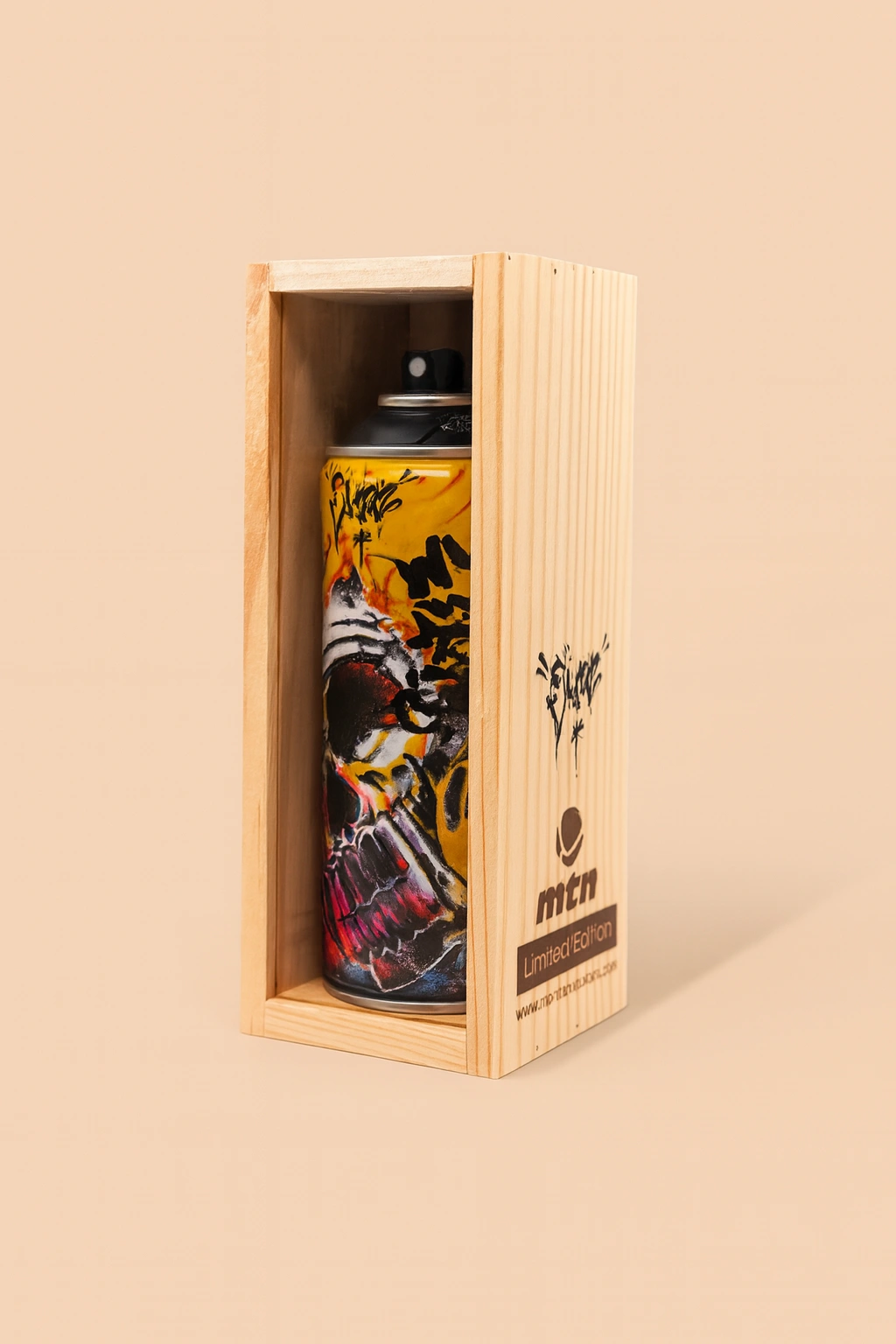“Barcode” (2004) by Banksy is one of the most iconic works from the elusive street artist, blending his signature wit, critique of consumerism, and stark visual style. In this piece, Banksy juxtaposes the mundane symbol of a barcode—typically associated with products and consumer culture—with the raw power and wildness of a tiger escaping its confines. Like much of Banksy’s oeuvre, Barcode invites viewers to question modern society’s priorities, particularly the way commodification shapes human lives and the natural world.
The Artwork
At first glance, Barcode is deceptively simple. The work depicts a tiger emerging from a barcode that doubles as a cage. The tiger, rendered in a stenciled, lifelike form, is caught mid-leap, dragging part of the barcode with it as though it has broken free. Above the barcode is a forested horizon, further emphasizing the contrast between the organic and the industrial.
The barcode itself, depicted as stark black and white lines, represents more than just a label for consumer goods. It is a universal symbol of modern capitalism—cold, utilitarian, and omnipresent. The tiger, in contrast, symbolizes untamed nature, vitality, and freedom. Together, these elements create a powerful visual metaphor for the struggle between natural instinct and societal control, as well as the constraints imposed by consumer culture.
The tiger’s escape from the barcode suggests rebellion—an act of defiance against the systems that seek to categorize and commodify all aspects of life. Banksy’s choice to render the tiger in a realistic style while keeping the barcode stark and mechanical heightens this dichotomy, emphasizing the clash between nature and the artificial constructs of capitalism.
Banksy and His Artistic Philosophy
Banksy’s art has always been deeply rooted in social and political commentary. Emerging from the Bristol street art scene in the early 1990s, he has since become one of the most influential and enigmatic figures in contemporary art. His work often critiques capitalism, consumerism, war, and authoritarianism, all while maintaining a sense of humor and accessibility.
In Barcode, Banksy encapsulates many of these themes. The piece challenges the viewer to consider how systems of commodification reduce living beings—including humans—to mere products. It also critiques how consumer culture infiltrates every aspect of modern life, often at the expense of individuality, creativity, and connection to the natural world.
Banksy’s use of stenciling, a hallmark of his style, is significant here. This technique allows for rapid reproduction and application in urban environments, making his works feel both ephemeral and ubiquitous. The simplicity of stenciling also mirrors the uniformity and standardization represented by the barcode, reinforcing the artwork’s themes.
The Socioeconomic Context of Barcode
Created in 2004, Barcode emerged during a period of significant globalization and technological advancement. The early 2000s were marked by the rise of multinational corporations, the widespread adoption of digital technology, and increasing concerns about environmental degradation. These developments profoundly shaped public discourse, making Banksy’s commentary particularly resonant.
The barcode, introduced in the 1970s, had by the early 21st century become an omnipresent symbol of globalization and consumerism. It represented not just the commodification of goods but also the dehumanization that often accompanies large-scale economic systems. For many, barcodes symbolized the loss of individuality in a world increasingly driven by market forces.
At the same time, environmental concerns were coming to the forefront of global consciousness. The juxtaposition of the tiger—a symbol of endangered wildlife—and the barcode underscores the impact of consumerism on the natural world. By 2004, tigers were among the many species facing threats from habitat destruction, poaching, and climate change, issues driven in part by the demands of global capitalism. Banksy’s artwork can be seen as a critique of humanity’s prioritization of profit over ecological preservation.
Themes Explored in Barcode
Consumerism and Commodification
At its core, Barcode is a critique of consumer culture and the way it reduces everything to a commodity. The barcode symbolizes the systems of categorization and control that underpin global capitalism, stripping objects—and even living beings—of their intrinsic value in favor of their market value. The tiger’s escape challenges this system, representing the possibility of reclaiming freedom and individuality.
The Clash Between Nature and Industry
The tiger and the barcode are starkly opposing symbols. The barcode represents industrialization, standardization, and control, while the tiger embodies wildness, instinct, and the natural world. By placing these elements in direct conflict, Banksy highlights the tension between humanity’s industrial progress and its detrimental impact on the environment.
Rebellion and Liberation
The tiger breaking free from the barcode suggests defiance against oppressive systems. It speaks to the human desire for freedom and the potential to resist societal constraints. This theme is a recurring motif in Banksy’s work, where acts of rebellion—whether by individuals, animals, or imagined figures—often serve as a call to action for viewers.
The Dehumanizing Effects of Capitalism
The barcode’s association with products also reflects the dehumanizing aspects of capitalism, where people are often treated as numbers, statistics, or resources to be exploited. The tiger’s escape symbolizes the struggle to reclaim humanity and individuality in a world increasingly dominated by economic systems.
Banksy’s Legacy and the Role of Street Art
Banksy’s work, including Barcode, has played a pivotal role in elevating street art from its underground roots to a respected form of contemporary art. His ability to blend striking visuals with sharp social commentary has made him a global phenomenon, attracting audiences far beyond traditional art circles.
Street art, as a medium, is uniquely suited to the themes explored in Barcode. Its public and often transient nature challenges the commodification of art itself, aligning with Banksy’s critique of consumerism. By placing works like Barcode in public spaces, Banksy ensures that his message reaches a broad audience, including those who might not typically engage with art galleries or museums.
Reception and Influence
Since its creation, Barcode has become one of Banksy’s most recognized works, celebrated for its simplicity and profound message. It has been reproduced in various formats, from prints to murals, allowing it to reach a wide audience. Critics have praised the work for its ability to convey complex ideas in an accessible and visually striking manner.
Barcode also continues to inspire contemporary artists and activists who seek to challenge societal norms and advocate for change. Its enduring relevance speaks to the universality of its themes, particularly as issues of consumerism, environmental degradation, and individual freedom remain pressing concerns in the 21st century.
Impression
Banksy’s “Barcode” (2004) is a powerful exploration of consumerism, environmentalism, and the human desire for freedom. Through its stark visual contrast and rich symbolism, the artwork invites viewers to question the systems that shape their lives and consider the possibility of resistance and liberation. Like much of Banksy’s work, Barcode transcends its medium, serving as both a critique of contemporary society and a call to action.
In a world where barcodes and consumer culture remain omnipresent, Barcode continues to resonate, reminding us of the importance of preserving individuality, protecting the natural world, and challenging the structures that seek to confine us. It stands as a testament to the enduring power of art to provoke thought, inspire change, and reveal the hidden complexities of our modern lives.
No comments yet.








